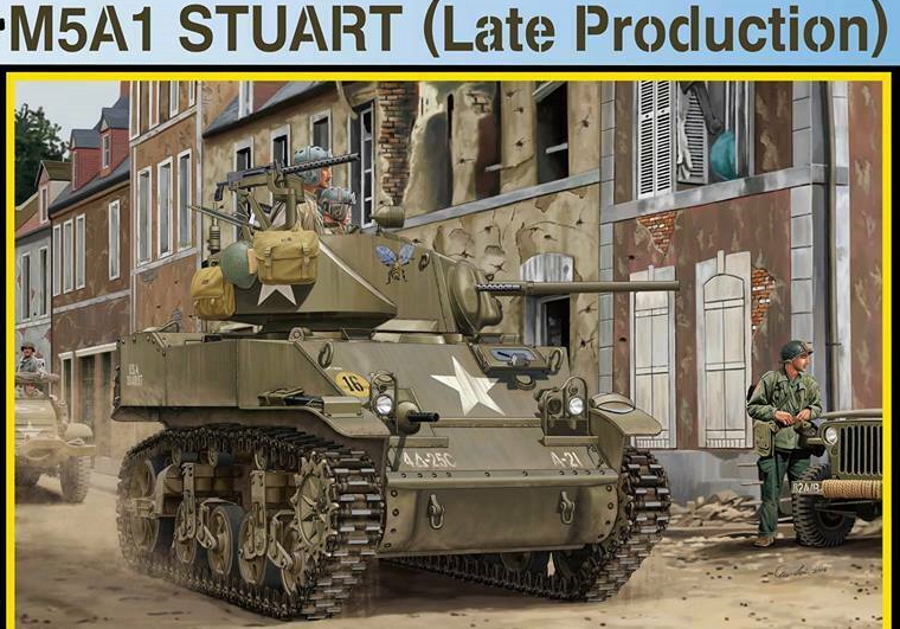
Light Tank M5 stemmed from a suggestion by Cadillac Division of GMC to the Ordnance Department that they should try the M3 light tank with twin Cadillac engines installed and the commercial Cadillac Hydramatic transmission which was produced for automobiles. In the fall of 1941, a standard M3 was converted as a trials vehicle (the M3E2) to test the idea and proved most successful. This made a trouble-free 500 mile trial run, and the Cadillac-powered vehicle proved easy to drive, and smooth to operate. Due to the always acute shortage of Continental engines, the Cadillac modified vehicle was approved for production and standardised as the Light Tank M5 in February 1942. It was originally to be designated Light Tank M4, but this was changed to M5 to avoid confusion with the M4 medium tank (Sherman), then going into production.
To accommodate the twin Cadillac engines, the rear engine covers were stepped up. But the hull was otherwise similar in shape to that of the welded M3Al apart from a sloping glacis. Turret installation, with basket and gyrostabiliser, was tested in another development vehicle, M3E3, while in the following July another Cadillac facility, at Southgate, California, also commenced production. At the same time Massey-Harris commenced M5 production in Racine, Wis, under the “parentage” of Cadillac, and finally, in October 1943, when M3 series production ceased, American Car & Foundry also switched to turning out M5s.
The M5A1 was designed and standardised in September 1942 to bring the M5 up to the standard of the much improved M3A3. Among changes common with the M3A3 were a new turret with bulge at the rear for a radio installation, larger access hatches for the driver and co-driver, improved mount for the 37mm gun, and improved vision devices. In addition there was better water-sealing on the hatches, an escape hatch added in the hull floor, and dual 93 traverse allowing the commander to train the turret while firing his AA machine gun. There were also detachable sand shields. A later modification was the provision of a detachable shield/fairing on the turret side to protect the AA machine gun mount. From early 1943, the M5A1 replaced the M5 on production lines.
VARIANTS
M5: Initial production type.
M5A1: Improved production type in line with improvements introduced in M3A3.
M5 Command Tank: Vehicle with turret removed and replaced with box-like superstructure and ·50 cal Browning machine gun in flexible mount. For use by senior officers.
M5A1 with Psy-war equipment: Standard vehicle fitted with loud hailer and associated public address equipment for Psychological Warfare units, 1944-45.
M5 or M5A1 with Cullin Hedgerow Device: Standard vehicles with “prongs” made from beach obstacles by field maintenance units for cutting through “bocage” hedges and undergrowth, Normandy, June 1944.
M5A1 with E7-7 Flame-gun: Flame-thrower equipment replacing main gun. Short projector and fuel stowed in hull. Same equipment could be fitted in M3A1.
M5Al with E9-9 Flame-throwing equipment: This was based on the British Crocodile idea (qv) and consisted of a flame projector replacing the hull machine gun, and fuel led, via an armoured pipe, from a towed trailer. Prototype only, started April 1943.
M5A1 with E8 Flame-gun: Developed from January 1943, this vehicle had the original turret removed, a new box-like superstructure added with a flame-gun carried in a small rotating turret at the top. It was a prototype only.
M5 with T39 Rocket Launcher: T39 Rocket Launcher mounted on turret top and controlled in elevation and traverse by vehicle’s gun and main armament. Fired 20 x 7·2 in rockets. Project only, 1944.
M5 Dozer: M5 light tank with turret removed and fitted with dozer blade at front end, 1944. A few vehicles so fitted retained the turret.
T27, T27E1 81mm Mortar Motor Carriage: This resulted from an army requirement for a mortar carrier on the M5Al chassis. A prototype, T27, was built with turret removed and an armour superstructure added, 18in high and 25mm thick. Mortar was mounted to fire forward with 35 degree traverse and a ·50 cal MG was also fitted. An alternative design, the T27E1, was similar except that the 81mm mortar was mounted lower in the hull so that it did not project above the superstructure. Both were cancelled in April 1944, after tests, due to inadequate crew and stowage space.
T29 4·2in Mortar Motor Carriage: Following cancellation of the T27 vehicles, this was produced with the mortar space enlarged and utilising a more compact mortar. Crew space for operating the mortar was still found inadequate and the project was terminated in this form.
T8 Reconnaissance Vehicle: This was a conversion of redundant M5 light tank chassis in 1944 by removal of the turret and the fitting of a gun ring mounting a ·50 cal Browning MG in its place. Prototype for the conversion was known as the Reconnaissance Vehicle “B”. T8s were in service as a “limited standard” type in 1944-45. A modified type with extra stowage racks added and rack for carrying land mines was designated T8E1.
DEVELOPMENT VEHICLES: M3E2 was M3 converted to test twin Cadillac engine installation. M3E3 was fuller conversion with addition of turret basket and other features for M5 and was M5 light tank prototype. M5A1E1 was an experimental vehicle with automatic 37mm gun and wider tracks which did not progress past trials status, 1943, due to development of later and better light tank designs. An experimental AA tank version of the M5A1 was also produced with a twin·30 cal Browning MG mount replacing the turret; it did not proceed past trials status. Finally M5s and M5A1s were also tested with various forms of flotation gear for amphibious operations, but none past the trials stage.
BRITISH SERVICE
A small number of M5s and M5A1s were delivered to the British in 1943-44 and these were used in NW Europe from 1944.
Stuart VI: British designation for both M5 and M5A1 light tanks. Some Stuart VIs were converted to Command, Recce, or Kangaroo versions by removal of turret.